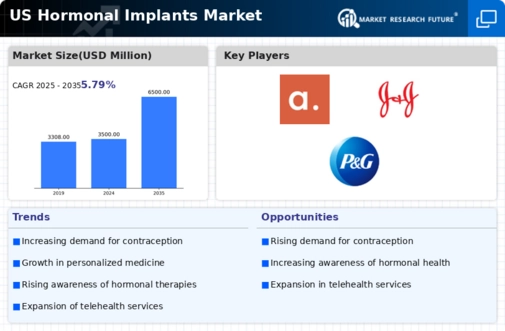Rising Healthcare Expenditure
In the US, increasing healthcare expenditure is contributing to the growth of the hormonal implants market. As individuals and families allocate more resources towards healthcare, there is a greater willingness to invest in long-term contraceptive solutions. The average annual expenditure on reproductive health services has risen by approximately 5% over the past few years, reflecting a shift towards preventive care and family planning. This trend suggests that consumers are more likely to consider hormonal implants as a viable option, thereby enhancing market potential. The hormonal implants market is poised to benefit from this trend, as more individuals seek effective and sustainable contraceptive methods.
Supportive Government Policies
Government policies in the US are increasingly supportive of reproductive health initiatives, which positively impacts the hormonal implants market. Programs aimed at improving access to contraceptive methods, including hormonal implants, are being implemented at both state and federal levels. For instance, the Affordable Care Act mandates coverage for contraceptive services, which has led to a rise in the utilization of hormonal implants. This supportive regulatory environment is likely to encourage more women to consider hormonal implants as a reliable contraceptive option. As policies continue to evolve, the hormonal implants market may see further growth driven by enhanced accessibility and affordability.
Technological Innovations in Healthcare
Technological innovations in healthcare are playing a crucial role in shaping the hormonal implants market. Advances in implant design and delivery systems are enhancing the effectiveness and user experience of hormonal implants. For example, the development of biodegradable implants and improved insertion techniques are making these contraceptives more appealing to consumers. As technology continues to evolve, the hormonal implants market is likely to benefit from increased adoption rates, as women seek out the latest advancements in reproductive health. This trend indicates a promising future for the market, as innovations drive both interest and accessibility.
Growing Awareness of Contraceptive Options
The hormonal implants market is experiencing a notable increase in awareness regarding various contraceptive options available to women. Educational campaigns and healthcare initiatives are emphasizing the benefits of long-acting reversible contraceptives (LARCs), including hormonal implants. This heightened awareness is likely to drive demand, as women seek effective and convenient methods of birth control. According to recent data, approximately 10% of women in the US are currently using hormonal implants, indicating a growing acceptance of this method. As healthcare providers continue to advocate for informed choices, the hormonal implants market is expected to expand further, catering to the needs of a more informed consumer base.
Changing Societal Attitudes Towards Family Planning
Societal attitudes towards family planning are shifting, which is influencing the hormonal implants market. There is a growing acceptance of various contraceptive methods, including hormonal implants, as women increasingly prioritize reproductive autonomy. Surveys indicate that nearly 60% of women in the US support the use of long-acting contraceptives, reflecting a cultural shift towards proactive family planning. This change in perception is likely to drive demand for hormonal implants, as more women seek effective solutions that align with their personal and professional goals. The hormonal implants market stands to gain from this evolving landscape, as societal norms continue to embrace diverse reproductive choices.














Leave a Comment